By using our website, you agree to the use of cookies as described in our Cookie Policy
Why Glass Shape Affects the Taste of Champagne
When the subject of champagne arises, it’s often accompanied by a debate on which glass best suits the sparkling wine. However, the evolution of the champagne glass is much more complex and historically significant than a discussion of glass shape would at first imply. Here, our editors explore the history of the champagne glass, including the evolution of glass composition, the essential shapes that collectors and committed champagne aficionados seek out, and the affect that a glass has on the taste and experience of a sip of champagne.
Champagne and the Restoration
Champagne, though not quite as we know it today, first arrived in England with the exiled Norman, Chevalier de Saint-Évremond, in 1670 and rapidly assumed prime position as Charles II’s favorite libation.
Shortly after, in 1674, the invention of lead glass by George Ravenscroft changed the art of glassmaking forever. Ravenscroft’s discovery was only made possible by the higher temperatures maintained over longer periods achieved by coal- (as opposed to wood-) fired ovens. It would, of course, have important ramifications.
The Importance of Lead Glass
Lead glass paved the way for innovative new techniques. First, glassmakers could manipulate their material in its softened state for longer. This led to glass free from the trapped air bubbles so characteristic of earlier English, Bohemian and Murano glassware.
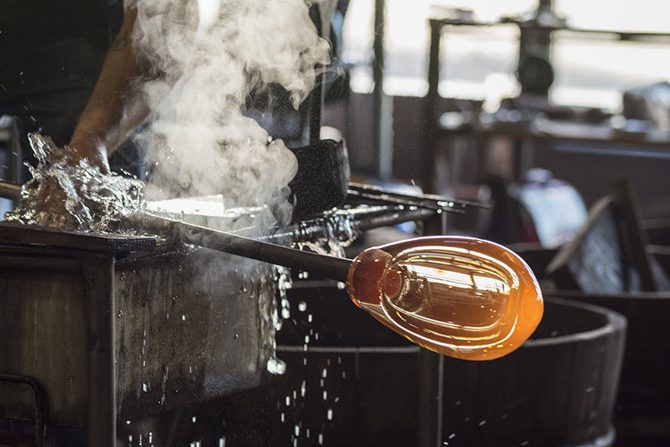
Second, artisans had more leeway: they could manipulate soft glass more freely, and they could now use cutting and etching techniques that would have shattered soda glass, the predecessor of lead glass. Another advantage was that lead glass could be made thin, yet remain strong: a useful characteristic for drinking glasses.
Of equal aesthetic value is the fact that the lead oxide content of the new glass made it more refractive than its soda-based counterpart. This refraction creates the sparkle that drove people to (incorrectly) refer to lead glass as crystal.
Perhaps the most important asset of the new lead glass was for champagne producers, as it allowed them to introduce the second fermentation in the same bottle; what’s known today as méthode champenoise or traditionelle.
The First Champagne Glasses
As with other contemporary fashions, champagne consumption soon filtered down from the court to the upper classes. Yet in the early days of champagne, there was no glass specifically made for its consumption. As it was an alcoholic carbonated drink, it was generally consumed from the same glasses as beer and cider. These had simple, short stems and round, funnel-shaped bowls.
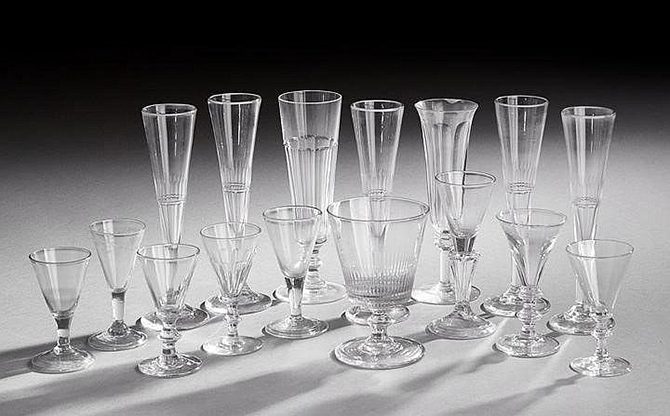
Collection of Sixteen Period Wine Glasses, Sold via New Orleans Auction Galleries for $430 on July 28, 2012.
In the latter part of the Georgian period (1714–1837), around 1800, such glasses developed a knop halfway down the stem. Two decades later, more decorative elements were added to the bowls. Vessels for beer were sometimes etched with depictions of barley, while cider glasses featured apples. It is rare, though not unheard of, to find examples etched with vines, which would have held champagne.
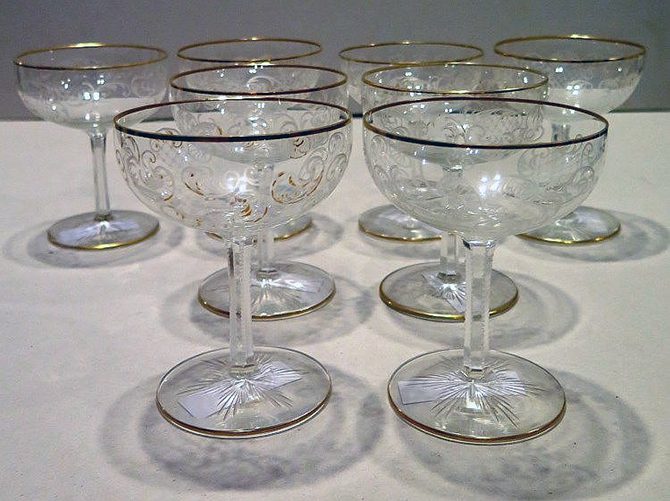
Set of eight crystal engraved and gilded champagne glasses, offered on September 5, 2015 via Galartis.
It was not until after 1830 that the champagne glass arrived on the English scene, despite its popularity throughout the Regency period. The coupe (a shallow, broad-rimmed, stemmed vessel) was, as far as it is known, the first “official” such glass. It’s thought that the open bowl was favored precisely because it allowed the mousse (then considered vulgar) to disperse.
Glassware in Russia
French wines, and champagne in particular, were fashionable among the aristocracy of the 19th century. Indeed, Russia at the time was the world’s second largest consumer of champagne, and the Imperial Glass Factory produced a range of different champagne-specific glasses for the banqueting sets of the Imperial Court and its palaces outside St Petersburg
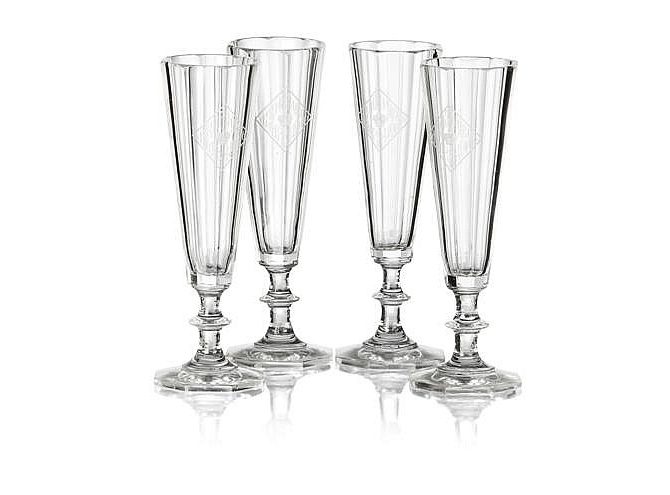 .
.
Four Russian Imperial Glass Works Champagne Flutes from a Banquet Service, 19th century. Sold via Lyon & Turnbull for £1,300 on March 26, 2013.
Flutes, some in brilliant cobalt blue, were decorated with silver and gold floral motifs, and often with the crest or cipher of the relevant court personage. Darin Bloomquist, Head of Department for Russian Works of Art at Sotheby’s, notes that, “During the second half of the 19th century, artists at the Imperial Glassworks produced objects in a variety of historical styles, including neo-Gothic and a traditional, national Russian Style which rejected Western motifs. By the end of the century, the influence of Art Nouveau had been fully embraced by designers and craftsmen.”
As in Western Europe, the effects of Orientalism on the decorative arts were revealed in the interior furnishings of the upper classes. In 1862, the Factory introduced techniques that imitated the enamel colors and architectural motifs of the Mameluke dynasties of the late 12th and early 13th centuries.
The Late Victorian Era to the 1920s
One of the great myths about champagne (aside from that concerning the contribution of Marie Antoinette) is that the coupe was simply superseded by the flute. In truth, there has never been one dominant type of champagne glass.
As champagne consumption spread, so did the variety of glasses. In England, glassmaking was in demand among crystal manufacturers such as Edinburgh and Leith, and Thomas Webb & Sons (later Webb’s Crystal Glass Company Ltd.). Their owners would travel the world in search of both designs and customers.
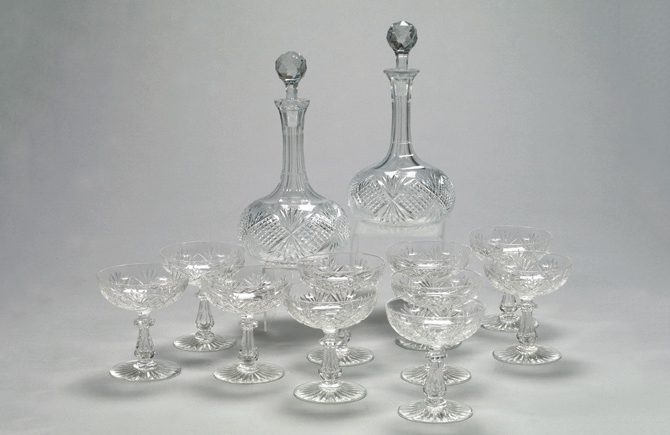
Set of Ten Edwardian Cut-Glass Saucer Champagne Goblets, in “Strawberry-Diamond-and-Fan” decor, c. 1900, probably Thomas Webb and Sons or Stevens and Williams, offered via New Orleans Auction Galleries on January 24, 2003.
Webb’s Rock Crystal style, created by engravers William Fritsche and Frederick Kny around 1878, involved deeper engraving and polishing of the cut areas. These had previously been left rough in order to show off the distinction between surfaces. The Rock Crystal effect, by contrast, amplified the refractive nature of the glass.
Russian pattern (also called Cobweb) cut glass was in high demand among the American gentry at the end of the 19th century, perhaps due to the fact that the White House ordered two sets of the glassware, in 1885 and 1891, with later additions. The patent holder, Thomas Hawkes, arrived on the European stage after winning the Grand Prix at the Paris Universal Exposition of 1889 for his collection of T.G. Hawkes cut glassware.
Champagne glasses produced in the Edwardian period (1901–1910) continued to be quite delicate. Decoration was either finely engraved, with classical references (floral or Grecian patterns), or cut in stylized shapes (cross hatches and stars). Thomas Webb & Sons’ classic shape at this time was a slightly flared bowl, sometimes with cut feet.

Antique Art Deco Crystal Champagne Saucers, early 20th century, sold via Akiba Antiques for $90 on June 21, 2017.
The 1920s are seen today as the era of the champagne coupe or saucer. Yet, aside from a period of Art Deco influence on decorative motifs (1925–1930), there is no single dominant style. Rather, it was an era of experimentation, from heavy sets of Bohemian-style overlay (some weighing over 200g per glass) to Russian-pattern cut flutes.
The Impact of Glass Shape on Taste
What effect do any of these styles and shapes have on the drinker’s appreciation of champagne? There are several (perhaps unexpected) factors to consider.
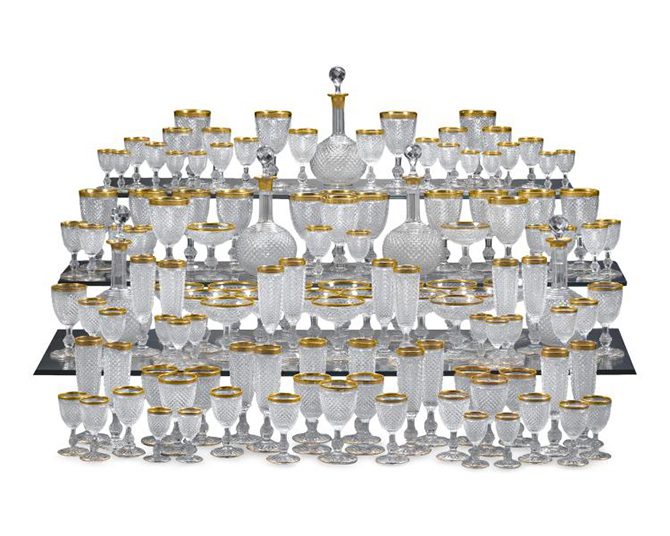
Baccarat Crystal 128-Piece Service, offered via M.S. Rau Antiques on June 24, 2017.
In terms of shape, while flutes tend to better retain mousse, a high-quality champagne will not lose its bubbles quickly. But it’s important to remember that, as with any good wine, aroma is an important element in the enjoyment of champagne. A wider bowl allows more aromas to escape from the wine’s surface, which gives the drinker a greater appreciation of the champagne’s complexity.
Tom Harrow, a Dom Perignon ambassador and Franciacorta’s U.K. ambassador, says that “Saucers are glorious, but impractical. And flutes are awful: you can’t swirl the wine, it slops everywhere.” Harrow himself prefers a tulip glass, but one that tapers dramatically so as to capture aromas.
“It really does depend on the style of the wine,” he explains. “Pinot Noir-dominated champagnes are pretty good in the Riedel Pinot Noir glass with a lip. Krug, on the other hand, tend to use quite big bowl glasses, but the wine is extremely rich and complex.”
The depth of the bowl where it joins the stem, not just its shape, also affects bubble retention. A deeper base creates one steady stream of bubbles, rather than the mass fizz created by rounder bases.
There is increasing evidence to show that the shape of a glass also affects the taste of its contents. In this case, the coupe may be a wise choice for sparkling wines without autolytic character. It helps to disperse the mousse and allows fruit flavors to reveal themselves quickly for instant gratification.
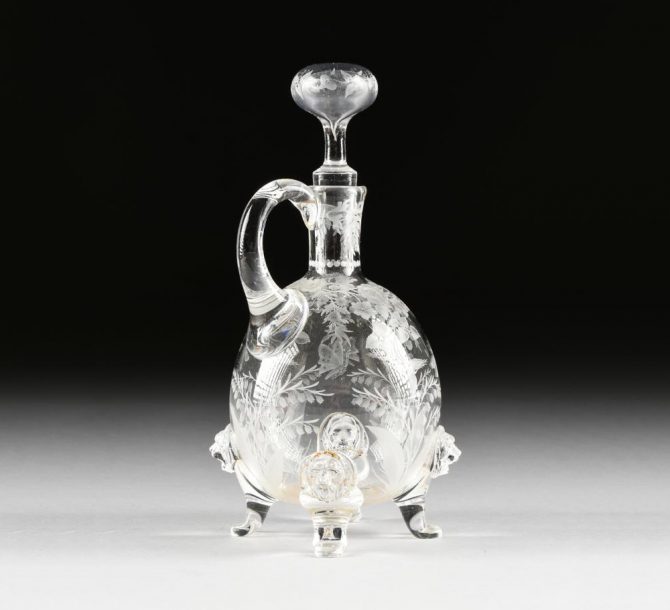
A Thomas Webb & Sons Copper-Wheel engraved “Rock Crystal” Glass Footed Ewer with Stopper, Stourbridge, England, circa 1885. Sold via Simpson Galleries for $550 on June 10, 2017.
However, for champagne collectors with a bottle of something as monolithic as the Bollinger R.D. 2002, Harrow suggests a champagne decanter. “It sounds odd to many people, but with a wine that needs plenty of time to open, something like the Billecart-Salmon champagne decanter makes sense.”
Finally, when washing glasses for champagne, always use dish soap for washing by hand. This ensures that residue will not affect the mousse.
‹ Back

